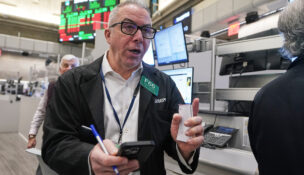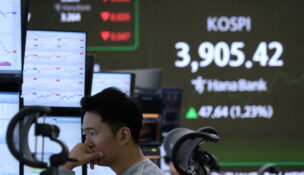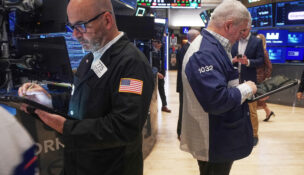Wall Street drifts as Oracle rallies and Boeing sags

Specialist Glenn Carell works on the floor of the New York Stock Exchange, Tuesday, June 10, 2025. (AP Photo/Richard Drew)

Specialist Glenn Carell works on the floor of the New York Stock Exchange, Tuesday, June 10, 2025. (AP Photo/Richard Drew)
Wall Street drifts as Oracle rallies and Boeing sags
SUMMARY:
- S&P 500 gains 0.2%, nearing all-time high
- Inflation report shows wholesale prices cooler than expected
- Fed rate cut expectations grow despite weak jobless data
- Oracle stock climbs after strong earnings and growth forecast
NEW YORK (AP) — U.S. stock indexes are drifting on Thursday following another encouraging update on inflation.
The S&P 500 was 0.2% higher in midday trading and sitting less than 2% below its record. The Dow Jones Industrial Average was down 18 points, or less than 0.1%, as of 11 a.m. Eastern time, and the Nasdaq composite was 0.2% higher.
Oracle pushed upward on the market after jumping 13.2%. The tech giant delivered stronger profit and revenue for the latest quarter than analysts expected, and CEO Safra Catz said it expects revenue growth “will be dramatically higher” in its upcoming fiscal year.
That helped offset a 5.6% loss for Boeing after Air India said a London-bound flight crashed shortly after taking off from Ahmedabad airport Thursday with 242 passengers and crew onboard. The Boeing 787 Dreamliner crashed into a residential area near the airport five minutes after taking off. The cause of the crash wasn’t immediately known.
Stocks were broadly getting some help from easing Treasury yields in the bond market following the latest update on inflation. Thursday’s said inflation at the wholesale level wasn’t as bad last month as economists expected, and it followed a report on Wednesday saying something similar about the inflation that U.S. consumers are feeling.
Wall Street took it as a signal that the Federal Reserve will have more leeway to cut interest rates later this year in order to give the economy a boost.
The Federal Reserve has been hesitant to lower interest rates, and it’s been on hold so far this year after cutting at the end of last year, because it’s been waiting to see how much President Donald Trump’s tariffs will hurt the economy and raise inflation. While lower rates can goose the economy by encouraging businesses and households to borrow, they can also accelerate inflation.
The yield on the 10-year Treasury fell to 4.38% from 4.41% late Wednesday and from roughly 4.80% early this year.
Besides the inflation data, a separate report on jobless claims also helped to weigh on Treasury yields. It said slightly more U.S. workers applied for unemployment benefits last week than economists expected, and the total number remained at the highest level in eight months.
“We believe that were it not for the uncertainty caused by the tariffs, the combined information coming from the inflation and labor-market data would have compelled the Fed to have resumed cutting its policy rate by now,” according to Thierry Wizman, a strategist at Macquarie.
The Fed’s next meeting on interest rates is scheduled for next week, but the nearly unanimous expectation on Wall Street is that it will stand pat again. Traders are betting it’s likely to begin cutting in September, according to data from CME Group.
Trump’s on-and-off tariffs have raised worries about higher inflation and a possible recession, which sent the S&P 500 roughly 20% below its record a couple months ago. But stocks have since rallied nearly all the way back on hopes that Trump would lower his tariffs after reaching trade deals with other countries.
Many of Trump’s tariffs are on hold at the moment to give time for negotiations, but Trump added to the uncertainty late Wednesday when he suggested the United States could send letters to other countries at some point “saying this is the deal. You can take it or you can leave it.”
In stock markets abroad, indexes were mixed across Europe and Asia amid mostly modest movements. Hong Kong’s Hang Seng was an outlier, and it tumbled 1.4% to give back some of its strong recent gains.
Hong Kong’s index is still up nearly 20% for the year so far, towering over the the U.S. stock market‘s gain of less than 3%.
___
AP Writers Matt Ott, Elaine Kurtenbach and Seung Min Kim contributed.
P
















